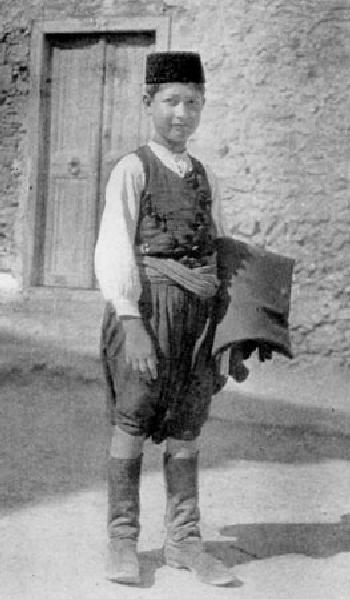
Greek Regions: Cretan Traditional Clothing

Figure 1.--This boy wears trafitional clothing, still common on Crete during the early-20th century. This photogfrph was probably taken about 1910. He wears destincrtive Cretan boots. Note the cap, it looks like a shotened Turkish fez. This shows the influence of the Ottoman era.
|
|
Many traditions are preserved in the villages of Crete, especially in the more isolated ones. What we now call folk costume is what men ansd women still commonly wore vefore World War I and was still quite common at the time of World War II. Today traditiional styles are not as common as they once were, especially with men and boys.
We do note quite a number of older men wearing these styles, especially in the more isolated villages or throughout Crete for special occassions. This are the costume we see folk dancers wearing with regional variations.
The standard costume can make quite a statement. It includes the classic black kerchief with fringes worn to cover the head, a light-colored woven shirt, black vest (meidanogileko), and destinctive 'vraka' (salvari) trousers. The vraka are tiied around the waist with a very long (10 meter) silk scarf.
When the weather turns cold,
men and boys cover their shoulders with a cape to keep warm. They also wear warm white boots (stivania). There are of course regional variants. In some areas men wear fezes with a navy blue tassel (sfakiano), a style which became popular during the Ottoman period. Belts can be black or red. Shirt and capes are often decorated with elaborate embroidery. Knives were often worn with the outfit, especially for special occassions.
A British reder tells us, "When I was stationed in Cyprus doing my National Service the old men, usually shepherds, wearing the Vraka. It always looked as if the garment was a skirt with the front hem pulled between the legs and then with the back hem, tucked into the waist at the back. It was secured with a long band wrapped around the waist.
There was an old wives tale that when Christ came again he would be born of man and the Vraka would be where he would be found! This was told to my wife by our Armenian maid. I am not sure whether this was a widespread tale, but it must be in the folklore."
HBC

Navigate the Boys' Historical Clothing Web Site:
[Return to the Main Crete page]
[Introduction]
[Activities]
[Biographies]
[Chronology]
[Clothing styles]
[Countries]
[Bibliographies]
[Contributions]
[FAQs]
[Glossaries]
[Images]
[Links]
[Registration]
[Tools]
[Boys' Clothing Home]
Navigate the Boys' Historical Clothing Belgin pages:
[Return to the Main Greek regional page]
[Greek choirs]
[Greek folk costumes]
[Greek movies]
[Greek royals]
[Greek schools]
[Greek youth groups]
Created: 4:47 AM 4/24/2012
Last updated: 12:15 AM 4/25/2012



